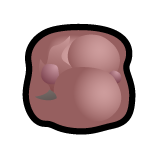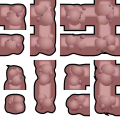Difference between revisions of "Fleshmass"
(this will need to be a lot more 'fleshed' out, possibly needing a disambiguation for everything classified as 'fleshmass') |
m (broken link) |
||
| Line 43: | Line 43: | ||
}} | }} | ||
| − | '''Fleshmass''' is an organic cancerous growth consisting of [[Twisted flesh]] that forms several functional organ like structures and creatures in the form of [[Fleshbeasts]]. | + | '''Fleshmass''' is an organic cancerous growth consisting of [[Twisted meat|twisted flesh]] that forms several functional organ like structures and creatures in the form of [[Fleshbeasts]]. |
== Summary == | == Summary == | ||
Latest revision as of 20:32, 21 July 2024
| This article relates to content added by Anomaly (DLC). Please note that it will not be present without the DLC enabled. |
| Spoiler warning: This page may contain details about the gameplay that might be considered spoilers. If you wish to enjoy the content first hand, you probably shouldn't continue reading beyond this point. |
| This article is a stub. You can help RimWorld Wiki by expanding it. Reason: properties of targeting and destroying fleshmass, and possible need for a disambiguation page. |
Fleshmass
A solid mass of twisted flesh. It throbs and shivers with horrible life.
Base Stats
- Type
- Structure
- Beauty
- -6
- HP
- 40
- Flammability
- 70%
- Rotatable
- False
Building
- Passability
- impassable
- defName
- Fleshmass
Fleshmass is an organic cancerous growth consisting of twisted flesh that forms several functional organ like structures and creatures in the form of Fleshbeasts.
Summary[edit]
While Fleshmass can refer to many things, for our purposes it will refer to the Fleshmass wall primarily, and subsequently its derivatives in the form of unique entities and items. The Fleshmass wall itself is relatively weak and flammable, where in destroying one wall will also destroy multiple nearby and connected chunks of wall at a time. The wall is also quickly targetable via melee or ranged weapon, and the associated pawn(s) will continue to attack nearby fleshmass after the initial target is destroyed. This leads to less initial micromanagement but may also result in unwanted wall destruction or pawns getting 'distracted' from your intended target.
Structures[edit]
Fleshmass appears more passively and even beneficial in the Distress Signal quest and in the Undercave of the Pit gate entity. They are created upon map generation and remain static, and serve no real threat other than acting as a physical barrier and possibly concealing Fleshbeasts within unrevealed areas. These areas also generate with organ structures dispersed among the fleshmass, such as the ![]() Fleshbulb and
Fleshbulb and ![]() Flesh sack, which provide a source of lighting and valuable loot respectively.
Flesh sack, which provide a source of lighting and valuable loot respectively.
Fleshmass however takes on a more active and hostile role for the ![]() Fleshmass heart entity, appearing as dynamic growths of large fleshmass veins / tendrils that consume plant life to grow larger and spread over any passable terrain, and in the process accumulate a sizable population of Fleshbeasts residing in the many empty pockets between growths. Organ structures such as the defensive
Fleshmass heart entity, appearing as dynamic growths of large fleshmass veins / tendrils that consume plant life to grow larger and spread over any passable terrain, and in the process accumulate a sizable population of Fleshbeasts residing in the many empty pockets between growths. Organ structures such as the defensive ![]() Fleshmass spitter or the exploitable
Fleshmass spitter or the exploitable ![]() Nerve bundle will occasionally spawn within the expanding cacophony of fleshmass. Destroying enough of the Fleshmass itself will also prove dangerous, as there is a chance for Fleshbeasts to spawn out of nearby fleshmass, an inevitability when trying to reach the various organs or cutting growths off from the heart. The fleshmass wall auto-targeting mechanic can prove detrimental for this specifically: causing unnecessary destruction of Fleshmass wall and leading any pawn(s) to stray off course when trying to create concise paths through the mass.
Nerve bundle will occasionally spawn within the expanding cacophony of fleshmass. Destroying enough of the Fleshmass itself will also prove dangerous, as there is a chance for Fleshbeasts to spawn out of nearby fleshmass, an inevitability when trying to reach the various organs or cutting growths off from the heart. The fleshmass wall auto-targeting mechanic can prove detrimental for this specifically: causing unnecessary destruction of Fleshmass wall and leading any pawn(s) to stray off course when trying to create concise paths through the mass.
Items[edit]
Creatures[edit]
Fleshmass takes the form of pawns in the following Fleshbeasts:
Analysis[edit]
Gallery[edit]
Version history[edit]
- Anomaly DLC Release - Added.

